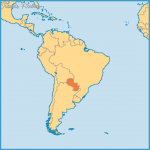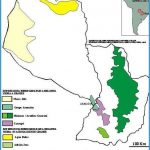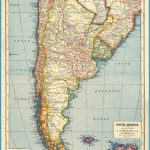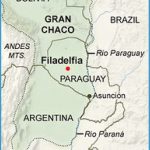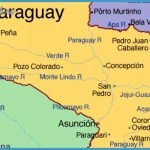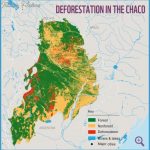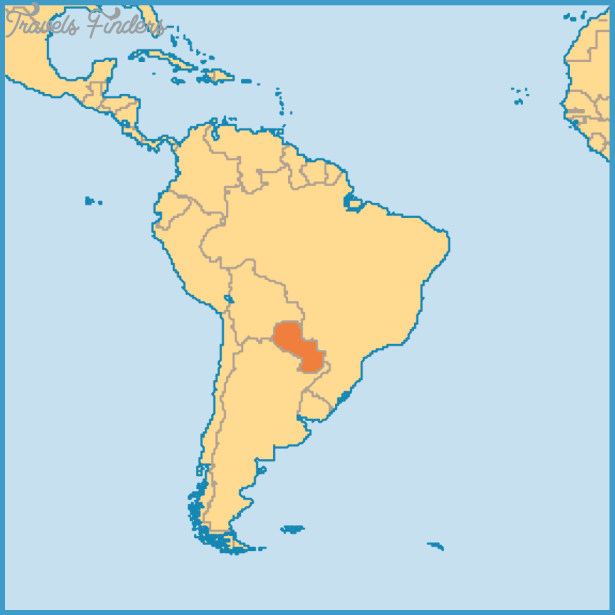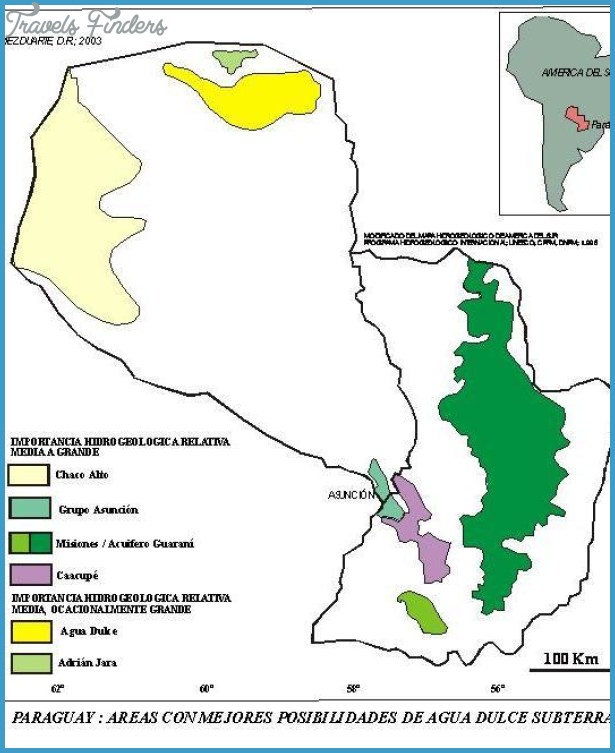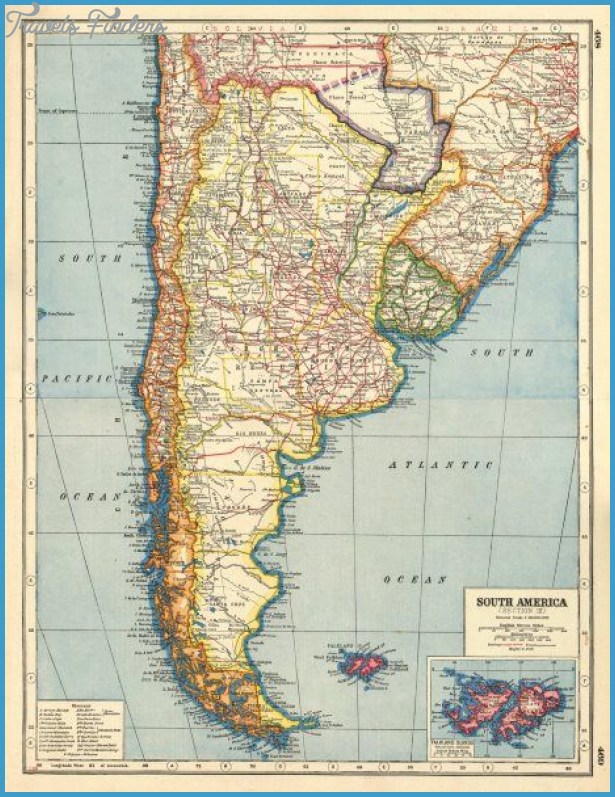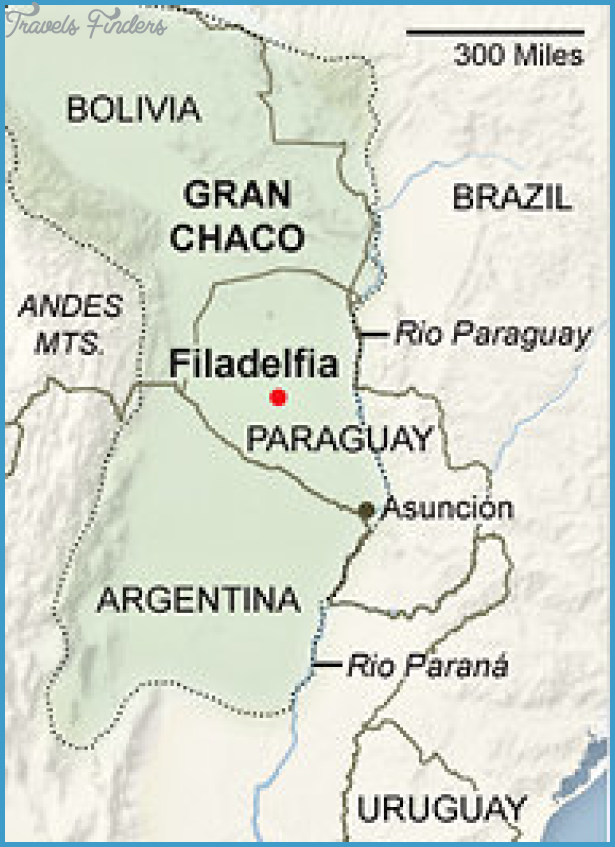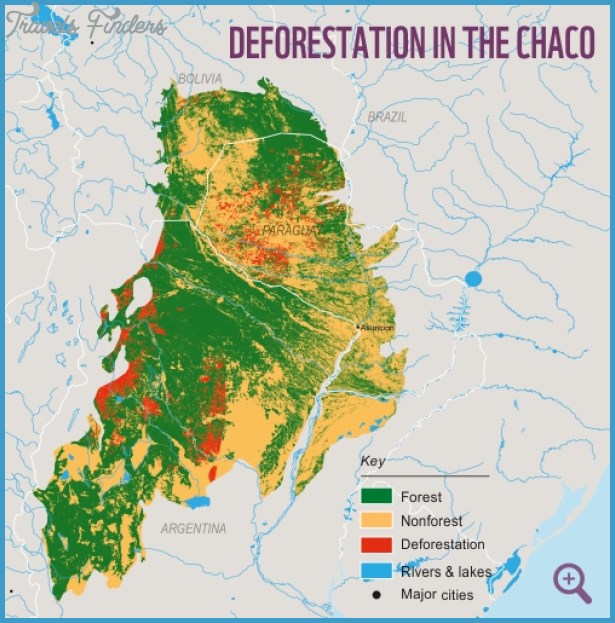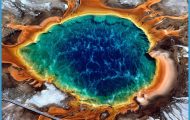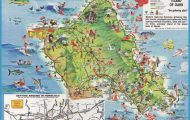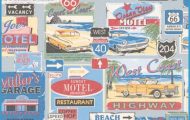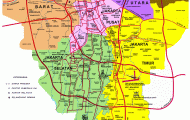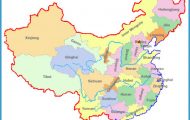The Chaco presents drivers with a series of challenges. The Trans Chaco Highway is a two lane road (one in either direction) stretching straight into the horizon without a bend in sight making it very difficult to judge the distance of oncoming vehicles. At night the road is illuminated only sporadically. The condition of the road itself is fairly decent until Filadelfia but begins to deteriorate thereafter (especially once past Mariscal Estigarribia). In the Northern (Alto/Dry) Chaco, the dusty clay ground leads to a phenomenon known as “talcal,” in which the road is covered with slippery dust. Military officers at Mariscal Estigarribia’s base jokingly refer to a nearby talcal-covered road as the ”tunel del tiempo” (the time tunnel) because once you start on it you never know when you will make it to the end. In addition to slowing down driving, the fine talcal can also obscure serious potholes. Approximately 120 kilometers north of Mariscal Estigarribia, the pavement ends and the talcal begins, giving way to sandy ground as one travels further north. It is generally unwise to veer off the asphalted road (even in and around the Mennonite communities) without a 4-wheel drive vehicle.
Adequate supplies, especially water and fuel should be packed. A good rule of thumb is to take at least one gallon (four liters) of water per person per day plus extra for the car radiator in case of overheating. Most Chaco experts recommend traveling with two spare tires. Between the potholes on the Trans Chaco Highway and plants with massive thorns (some up to a couple inches in length and thicker around than a ball point pen) along the side roads, it is better to be safe than sorry. Should you need them, spare parts for popular model vehicles can be obtained in the Mennonite colonies.
The Chaco’s Lifeline
Construction on the Trans Chaco highway began in 1956. The road proved essential for the economic development of the area, especially for the Mennonite colonies. Much of the assistance for the road’s construction came from the Mennonites themselves in the form of the Pax Boys, participants in the Mennonite Central Committee’s conscientious objector program (known as PAX). Over fifty Pax Boys came to Paraguay to help build the Trans Chaco Highway. Until the highway reached the Mennonite colonies in 1961, goods were transported to Asuncion by way of the Paraguay River, a journey which took days to complete. Today, the Trans Chaco Highway remains the only major paved road in the Paraguayan Chaco and is a lifeline for the region’s inhabitants. Mennonites and ranchers transport their dairy products (over 50 percent of Paraguay’s dairy production), crops, and cattle to Asuncion on enormous trucks while the region’s indigenous inhabitants travel along the road as they emigrate from remote villages to the city in search of employment. In addition, the road is a key transportation route for goods entering and exiting Bolivia.
Departamento Presidente Hayes
Chaco’i
Chaco’i is an excellent choice for a quick and easy taste of the humid (bajo) Chaco. Though technically in the Chaco, this small community is easier accessed by boat from the port of Asuncion (see Sports and Exploring Asuncion’s Natural Side).
Rutherford B. Hayes: Paraguay ‘s Favorite American President
Many Americans are bemused when they learn that one of Paraguay’s largest departments is named after American president, Rutherford B. Hayes. The 19th president of the United States played an extremely important role in Paraguayan history. In the aftermath of the disastrous Triple Alliance War, there remained several disputes over territory between Paraguay and the victors of war (primarily Brazil and Argentina). One such case was a large part of the Chaco to which Argentina laid claim. The region was to be divided into three sections. The territory between the Bermejo River and the Pilcomayo River was to pass into Argentine hands. The territory between the Verde River (just north of current day Pozo Colorado in the Central Chaco) and Bahia Negra (the northernmost border of Paraguay) would remain in Paraguayan hands, and the territory between the Pilcomayo River and the Verde River was to be submitted to international arbitrage by President Rutherford B. Hayes. In 1878 the American president ruled in favor of Paraguay, a decision which allowed Paraguay to retain a significant portion of the Chaco. Thus the department was named after the American president who is probably more revered and well-known in Paraguay than in his homeland.
Escuela Agricola San Francisco
Run by the Paraguayan NGO, Fundacion Paraguay, the Escuela Agricola San Fransisco is a boarding school and model farm where high school students from all over the country learn sustainable farming techniques. All of the farm’s products are organic, and environmental conservation techniques such as solar cooking and heating are practiced. In addition, the school has recently started a tourism training program, and guests are able to stay overnight in the hotel run by students and faculty. As you stroll the grounds be sure to look upwards to catch a glimpse of monkeys in the trees. The farm is an easy day trip from Asuncion by car or bus. It is best to visit during the week since most students return home on the weekends. There is also a small indigenous community next to the turn off to the school along the Trans Chaco that sells handicrafts. If you can’t make the trip, you can still support the school by visiting their stand in Asuncion’s Agroshopping farmer’s market (see Agroshopping). One of the most popular items is the farm’s deliciously rich Cerrito brand dulce de leche. Tel: 0271 272 223, Ruta Transchaco km 46.5 on the left-hand side (if coming from Asuncion), you will see the school’s yellow roadside stand (sign reads Parador Cerrito) after which you turn left and follow a dirt road approximately one mile until you reach the school campus, by bus catch the La Chaquena bus along Calle Brazil in Asuncion and ride it to the end of the line (approximately two hours), www.fundacionparaguaya.org.py, guided tours Gs. 20,000 per person, Double Gs. 60,000 per person, Wi-Fi Sidebar: Old Lady Tree – The Guaigui Pire (Ruprechtia triflora) tree’s name means old lady skin in Guarani in reference to the tight curls of bark that peel off the tree’s trunk.
Water in the Chaco: A Precious Resource
Fresh drinking water is fundamental for both humans’ and animals’ survival in the Chaco. During the Chaco War, major battles were fought in order to maintain access to fresh water lagoons, and dehydration was one of the main causes of death among soldiers. It is no coincidence that today the Chaco’s main population centers are near fresh water sources. During the dry season, droughts are often so severe that cattle ranchers are unable to keep their livestock from dying of
thirst. For indigenous communities relocated to remote areas, survival is highly dependent on motorized water pumps installed by the government.
Given the scarcity of this resource a variety of water collection methods are employed. Many people dig artificial ponds known as “tajamares.” Buildings are often fitted with rooftop gutters which channel water into above ground tanks. Another option is a system known as a tanque Australiano,” whereby windmills are used to pump water into a raised pond. When traditional water sources run dry, indigenous peoples still living in the wild often find themselves forced to leave the forest in search of water and end up drinking from water collection ponds in nearby cattle ranches.
With the Chaco’s population reaching unsustainable levels, water collection is only one piece of the puzzle. As of 2010 there were a number of desalinization plants operating in the region, and there are plans to create an aqueduct to transport water from the Paraguay River to the Mennonite colonies.
Escuela Pa Puku
After hours of driving along the Trans Chaco Highway, the Escuela Pai Puku is an interesting and heartwarming stop. This boarding school was created by a Belgian priest in 1965 (presumably he was tall, as Pai Puku means “tall priest” in Guarani) to educate children of the region whose parents mostly live and work in the surrounding cattle ranches (estancias). For nine months out of the year, students learn skills such as carpentry, dressmaking, nursing, plumbing, and electrical work. The school’s wood work shop is well known throughout Paraguay as a source of unique and well-made furniture. In typical Chaco fashion, the school’s buildings themselves are constructed almost entirely out of karanda’y (palm) logs which look a lot like toy Lincoln Logs. While visiting, be sure to check out the kitchen where an enormous cauldron hangs over a roaring fire as teachers prepare food for their 500 plus students. Donations in the form of school supplies are a nice way to repay the school for an informal tour. Tel: 0971 369 890, 0971 293 739, Ruta Trans Chaco km 157, www.paipuku. org
Parador Pirahu
An obligatory stop, Parador Pirahu has developed an almost religious following amongst Trans Chaco Highway regulars who enjoy the pit stop’s delicious food and unique diner-style ambience. The extensive menu includes a wide variety of empanadas and garlic sticks that pack a punch. Reliably clean bathrooms are an additional (and important) bonus. There is also an adjacent hotel which mostly caters to long haul truck drivers. Tel: 0991 700 683, Asuncion office 021 228 859, Ruta Trans Chaco km 249 (about twenty kilometers before Pozo Colorado), daily 6:30am -8:30pm, Gs. 3,000-30,000, room rates: Triple Gs. 160,000, TV, A/C
Pozo Colorado
Pozo Colorado marks the crossroads with Route 5 which heads east crossing over the Paraguay River to the city of Concepcion. Unless you are stopping for gas or to catch a bus to Concepcion, there is little reason to stop here. Most Trans Chaco buses make pit stops in Pozo Colorado. If you travel on one of these buses, don’t dawdle as they have been known to leave passengers behind.
Departamento Boqueron Filadelfia
As the capital of the Boqueron Department, Filadelfia is the epicenter of activity in the Central Chaco. It is the administrative center of the Fernheim colony which was founded by Russian Mennonites in 1930. Today, with its banks, supermarkets, gas stations, hotels, and restaurants, Filadelfia is an oasis of modernity just off the desolate Trans Chaco Highway. Though most Paraguayans associate Filadelfia with the Mennonites, there are a number of non-Mennonite residents as well. Walking down the wide, dusty streets you are as likely to see blonde farmers in overalls, as modern looking Paraguayans speaking on cell phones, and indigenous women wearing long skirts decorated with bright cartoonish prints. Indigenous and mestizo Paraguayans as well as Brazilians have been attracted to the area by the prospect of job opportunities. As with most Mennonite communities in Paraguay, Filadelfia is highly segregated with the majority of non-Mennonites living in the Barrio Amistad neighborhood and the city’s indigenous residents living in Barrio Villa Guarani. Here, houses are rudimentary, made of brick and corrugated tin roofs. Across town in the Mennonite neighborhoods, there are large German style houses with picket fences and well tended gardens. The Emerald City of the Paraguayan Chaco, Filadelfia is a strange but interesting place.
Of the Mennonite colonies, Filadelfia is the most frequented by tourists. Aside from the museum, however, there is little to see. Filadelfia is best used as a base of operations for nature visits. Though pricier than Asuncion, this is a good place to stock up on supplies before heading into the wilderness. Those particularly interested in Mennonite history can take public or private transportation to visit the museums of neighboring Loma Plata and Neuland (though for the average tourist, Filadelfia’s nicely organized museum will suffice). If your visit coincides with carnival (usually held between late January and early March), be sure to head over to the indigenous neighborhood to participate in the Arete Guazu (see The Arete Guazu). This is one of the few times when it is easy to interact with the local indigenous communities (for an even more unique experience, head to the Arete Guazu in Santa Teresita, just south of Mariscal Estigarribia).
Almost all of Filadelfia’s businesses are located along Avenida Hindenburg, one of the town’s few paved roads. This main drag is flanked by two large monuments. The first monument at the entrance to town is named “Living and Growing Together and was built in celebration of the Fernheim colony’s seventy-fifth anniversary. It features stylized forms representing the various ethnic groups that live in the area, all facing a large cross. Towards the other end of town is a similarly abstract monument to the fiftieth anniversary of the colony’s founding.

